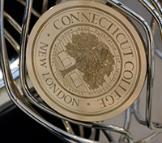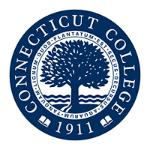Alma Mater
"Alma Mater by the Sea" was written in the spring of 1920 by two Connecticut College students, Olive Littlehales Corbin '21 (words) and Edith C. Smith '20 (music). Their composition prevailed over other original student works in a contest to find a College song. Additional stanzas were added in the late 1980s by Jeffrey G. Barnhart '89, MAT '92 and Claire L. Gaudiani '66.
College charter
The State Legislature chartered Connecticut College on April 5, 1911. The charter establishes the College as a legal entity, provides the authority to confer degrees, and creates a board of trustees to govern the institution. The chair of the board presents the incoming president with a copy of the charter during the installation ceremony as a sign of the trust and responsibility the College places in its new leader.
The College mace
 The College mace is carried by the College marshal on official occasions as a symbol of authority. The Connecticut College mace was a gift to the College from The Century Council, one of the College's giving societies, when Claire L. Gaudiani '66 began her presidency in 1988. Designed and fabricated by Richard Scheller '73, it contains brass sleeves with the names of the former College presidents.
The College mace is carried by the College marshal on official occasions as a symbol of authority. The Connecticut College mace was a gift to the College from The Century Council, one of the College's giving societies, when Claire L. Gaudiani '66 began her presidency in 1988. Designed and fabricated by Richard Scheller '73, it contains brass sleeves with the names of the former College presidents.
A mace was originally a weapon consisting of a staff with a ball of steel or brass at one end. The word "mace" comes from the Latin mateola, meaning mallet. The mace evolved from an instrument of battle to a symbol of authority. In London's House of Commons, the sergeant-at-arms carries a mace over his right shoulder. When he puts the mace down, the session may officially begin. The session comes to an end when the sergeant-at-arms picks up the mace.
College motto
The motto, "Tanquam lignum quod plantatum est secus decursus aquarum," translates "Like a tree planted by the rivers of water (that bringeth forth its fruit in its season)." The motto is a Vulgate version of a phrase from the First Psalm. Connecticut College’s translation comes from the King James version of the Bible.
 College seal
College seal
The seal is comprised of several elements, including two open books, a tree on a background of water and the College's motto. The current seal is based on a design created by the College’s first president (1913-1917), Frederick H. Sykes.
Greetings and delegates
Colleges invite representatives of various organizations, groups and government entities to bring greetings or express good wishes during the Inauguration. Other educational institutions and societies are also invited to send delegates to take part in the Inaugural procession. Many institutions, even if not represented by a delegate, send written greetings. A selection of the greetings received by Connecticut College on the occasion of the president's Inauguration will be on display at the Charles E. Shain Library.
The presidential medallion
Featuring the Connecticut College seal, the presidential medallion is worn on ceremonial occasions as part of the president's regalia. It was created for the Inauguration of the College's 10th president, Leo I. Higdon, Jr., and was a gift of Trustee Emeritus Linda J. Lear, a 1962 graduate of the College. The medallion is to be part of the installation ceremony at all Inaugurations. The chair of the Board of Trustees will present the incoming president with the medallion as a symbol of the authority entrusted to the new leader.
Palmer Auditorium
Built in 1939, Palmer Auditorium has been the setting for several Connecticut College Inaugurations. It was built in honor of Frank Loomis Palmer, an early trustee, with a bequest from his daughter Virginia. The architect was Shreve, Lamb and Harmon, the firm that designed the Empire State Building. Like that New York landmark, Palmer Auditorium has some art deco features in its stonework.